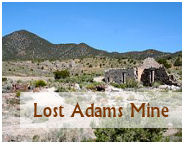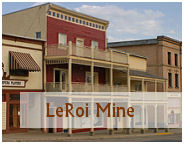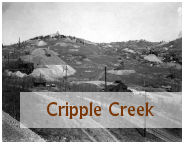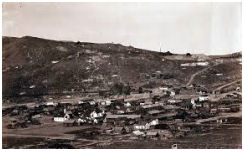During the California Gold Rush, a time when gold fever plagued even the most innocent and content of men, legends and stories of gold mines filled the hearts, souls and minds of prospectors, driving them into some of the most dangerous and desolate lands in search of gold. The desire for gold can be so great that it motivates men to endure unbelievable hardships including starvation, dehydration and death.
O land of gold, you did me deceive, And I intend you my bones to leave, So farewell home, now my friends grow cold, I’m a lousy miner; I’m a lousy miner, In search of shining gold. The Lousy miners, gold Rush-era song
The dry desert lands of the U.S. have been the location of many famous mines and gold discoveries. Mining towns such as Tumco, Bodie, Oatman and Randsberg were once booming with growth due to the mining operations. Bodie was pretty isolated and sat at an elevation of 8,400 feet.
Bodie began as a mining camp of little note following the discovery of gold in 1859 by a group of prospectors, including W.S. Bodie. People are not sure of Bodies first name although there are articles stating it was Willaim or Bill. Bodie perished in a blizzard the following November while making a supply trip to Monoville. He never got to see the rise of the town that was named after him. Townspeople felt that poor Bodie deserved a proper burial so in 1879 a W.S. Bodie services were held creating a monument on his behalf, but two years later after President Garfield was assassinated Bodies monument was adapted for Garfield and erected in the cemetery. No one is sure were in the cemetery Bodies remains are.
Bodie was a tough town. There were shootings almost everyday. This was a town that was filled with gamblers, drinkers and prostitutes. Everyone packed a gun in this town. The town was so bad that there was a so called vigilantie group named the 601. The 601 stood for 6 feet deep, zero trial and 1 rope. From the years 1878 to 1881, there were 70 fatal shootings in a town whose population fluctuated between 5,000 and 10,000. Of those shootings, 40 men were charged with murder. After a while the town ended up getting a lawman by the name of John Kirgan. John had served with an Illinois regiment in the 1846–48 Mexican War before news of gold lured him to California.
In 1876, the Standard Company discovered a profitable deposit of gold-bearing ore, which transformed Bodie from an isolated mining camp comprising a few prospectors and company employees to a Wild West boomtown. Rich discoveries in the adjacent Bodie Mine during 1878 attracted even more hopeful people. By 1879, Bodie had a population of approximately 5000–7000 people and around 2,000 buildings. One idea maintains that in 1880, Bodie was California's second or third largest city, but the U.S. Census of that year disproves the popular tale. Over the years, Bodie's mines produced gold valued at nearly US$34 million although there are some records that state that number could be much higher and closer to 80 million dollars worth of gold and silver.
Mining around Bodie was all hard rock mines and there were several different mines in the area. Bodie also had around a dozen stamp mills. The largest mill of course belonged to the Standard Mill. Work in these mills was noisy dirty job. These mills would have a dozen or more stamps pounding away 24 hours a day, 7 days a week powered with big steam engines roaring and rock crushers shattering rock. Of course all this steam power needed fuel to create steam and the fuel was wood. It is said that just one mill would burn through 20 cord of wood a day. Also these under ground tunnels needed wood for shoring as theer is said to be about 70 miles of underground tunnels in around Bodie.
The first signs of decline appeared in 1880 and became obvious towards the end of the year. Promising mining booms in Butte, Montana; Tombstone, Arizona; and Utah lured men away from Bodie. The get-rich quick, single miners who originally came to the town in the 1870s moved on to these other booms, which eventually turned Bodie into a family-oriented community. Then the Standard Mill burned down in 1898. That had a hard effect on the town. By 1920, Bodie's population was recorded by the US Federal Census at a total of 120 people. Despite the decline, Bodie had permanent residents through most of the 20th century, even after a fire ravaged much of the downtown business district in 1932. It has been said that 100 million dollars worth of gold and silver had been mined out from the hills around Bodie.
The stories of lost gold mines still lure prospectors to the hills around Bodie. Many believe it is easier to find a mine that has been lost, than to discover a new location. Today however Bodie is nothing more than a ghost town. However you can still go to Bodie from May to October each year as the town has been preserved as the Bodie State Park.










